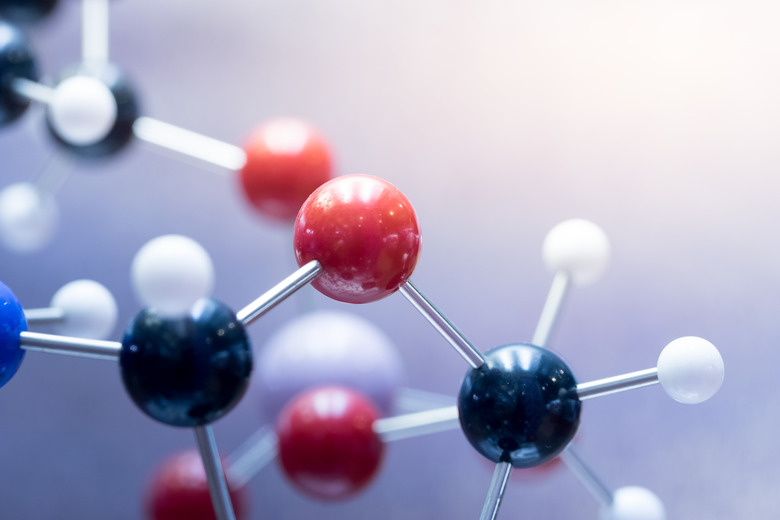The Difference Between Isotopes Of The Same Element
Elements are differentiated according to the number of protons in their nucleus. Hydrogen, for example, has one proton in its nucleus, while gold has 79. Protons have a positive charge and weigh one atomic mass unit. Nuclei also usually contain neutrons, which weigh roughly the same as protons but have no charge.
TL;DR (Too Long; Didn't Read)
Two atoms that contain the same number of protons but different numbers of neutrons are isotopes of the same element. Their masses are different, but they react the same way chemically.
Atomic Mass Number
Atomic Mass Number
Isotopes usually aren't given special names, with the exception of deuterium and tritium, which are hydrogen isotopes. Instead, isotopes are simply labeled according to their atomic mass number. This number refers to the mass of the element's nucleus. Because protons and neutrons have roughly the same weight, the atomic mass number is simply the sum of the protons and neutrons in the nucleus. All carbon has six protons, but different isotopes have different numbers of neutrons. Carbon-12 is the most common, with six neutrons, but carbon-13 and carbon-14 — with seven and eight neutrons, respectively — also occur naturally.
Chemistry
Chemistry
Positive and negative charges attract. For an atom or molecule to be stable, it must have a net charge of zero, meaning that the positive and negative charges cancel each other out. The number of positively charged protons in the nucleus determines the number of negatively charged electrons that orbit the nucleus. Chemical reactions are driven by the interaction between the positive and negative charges — the protons and electrons — of different atoms. Because neutrons aren't positive or negative, they don't influence chemical reactions. In other words, different isotopes don't behave any differently during chemical reactions or when forming compounds. They're distinguished only by weight.
Average Isotopic Mass
Average Isotopic Mass
The periodic table lists the atomic masses of each element. Usually, this number is a decimal rather than a whole number. This isn't because an individual atom of hydrogen weighs 1.0079 atomic mass units — neutrons and protons each weigh one atomic mass unit, so any given atom has a whole-number value for mass. The number listed in the periodic table is a weighted average of the naturally occurring isotopes of an element. Nearly all hydrogen has just one proton and no neutrons, but a small percentage of hydrogen has one or two neutrons and is called deuterium or tritium. These heavier isotopes skew the average weight slightly higher.
Isotope Stability and Occurrence
Isotope Stability and Occurrence
Certain combinations of protons and neutrons are more or less stable than others. Generally speaking, the frequency of an isotope in nature is determined by its stability. The most stable isotopes are also the most common. Certain isotopes are unstable to the point of being radioactive, meaning they decay over time into some other element or isotope and release radiation as a byproduct. Carbon-14 and tritium, for example, are both radioactive. Certain extremely radioactive isotopes don't exist in nature because they decay too quickly, but others, such as carbon-14, decay slowly and do occur naturally.
References
Cite This Article
MLA
Moll, Eric. "The Difference Between Isotopes Of The Same Element" sciencing.com, https://www.sciencing.com/difference-between-isotopes-same-element-8754168/. 23 April 2018.
APA
Moll, Eric. (2018, April 23). The Difference Between Isotopes Of The Same Element. sciencing.com. Retrieved from https://www.sciencing.com/difference-between-isotopes-same-element-8754168/
Chicago
Moll, Eric. The Difference Between Isotopes Of The Same Element last modified March 24, 2022. https://www.sciencing.com/difference-between-isotopes-same-element-8754168/
